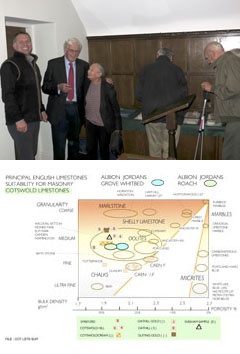The guest speaker at the Men of the Stones meeting in Stamford, Lincolnshire, in October was Maurice Rogers, the bane of the stone testing centres.
Maurice Rogers, an engineer who spent much of his working life in quality control, is a thorn in the side of those involved in stone testing, such as BRE and Sandbergs. Yet he has become a hero of some of the architects and organisations involved in building restoration in the Midlands where he lives, including the National Trust.
Maurice said his presence at the Men of the Stones meeting was due to an accident. Although he had always been interested in geology and knew his stones, he had first become involved in the stone sector in the restoration of a church at Clifton-on-Dunsmore. Then, in 2010, he had advised the National Trust on the Arden sandstone needed for the restoration of Baddesley Clinton in Warwickshire. He sourced the stone for Baddesley Clinton by identifying and opening up a small corner of a disused and overgrown quarry nearby (read more about that here).
He found the old quarry by following the 400 yard rule, he said. That is, the stone in old buildings would have been transported as short a distance as possible, which usually means the source of it can be found within 400 yards of the building. One church he had been involved with was actually built in the quarry from which its stone came. At Baddesley Clinton the quarry was 50 yards from the house.
Maurice's new career with the stone industry has left him highly critical of the tests used to determine properties of stones such as 'apparent density' and 'lowest expected value'. His criticism is that these terms are made up and imprecise, giving values that include a proportion of failures, which is anathema to a man involved in quality control all his life where failure could lead to serious injury or even death.
It is not unknown for stone to fall off buildings, although it has traditionally been centuries after it was installed. It is often what prompts building renovation work. Failure in new stonework, from facades to floors, is less expected. But it happens. Sometimes thin stone on facades breaks around the fixings. Sometimes the fixings fail. On floors, stones can crack or break up. It happens because not enough care has been taken to match the stone with the way it is fixed or laid.
Maurice's inability to obtain acknowledgement and support for his approach from the laboratories involved in testing stone, and sometimes what he considers obfuscation from them in answering his questions, has frustrated him.
He believes there are easy indicators that all quarries could use to assess the quality of their stone as it is produced, rather than sending samples away for expensive testing in laboratories as required for CE marking.
Water absorption, for example, can be ascertained simply by putting a piece of stone in water and measuring how far up the stone the water travels in a determined period of time. Maurice has produced graphs that provide clear indications of correlations between these simple water absorption tests and frost resistance. It gives you an answer in half-an-hour rather than waiting weeks to find out the results of expensive repeated freeze thaw cycles carried out in a laboratory.
Using this information enables him to select appropriate stone for restoration and conservation work. "Architect after architect is asking me to match stones for them," Maurice told the Men of the Stones.
The week before the Stamford meeting, he said, he had met with representatives of English Heritage to discuss his approach to stone selection with them.
His talk to the Men of the Stones was entitled 'Conservation and Repair of Historic Buildings in the Midlands'. He spoke about various projects he had been involved with where he had identified the particular nature of the stone and how that had affected how it had aged, changing colour with mineral reactions and lichen growth, and which stone would match it for replacement.
Some unexpected properties of stone had been discovered. In Hanbury Hall, Worcester, for example, it was found that the sandstone used contained chlorite that had acted more as a cement than the silica in it. And the stone from North Woodloes, quarried for Warwick Court House, was found to shrink by 0.5% after a month of being taken out the ground.
The particular conditions where a stone has been used will also effect how it deteriorates. At Kelmarsh Hall, Ketton limestone was as fresh as the day it was cut in most places but on the steps it had eroded because salt had been put down in freezing weather to make the steps safe to use.
At Dunchurch, Maurice discovered that the parish church had been started in one stone and suddenly changed as building went on. When he determined the sources of the stone he found that the quarry used for the original stone was further away than the source of the later stone. Presumably the stone further up the building was discovered after work had already started and as it was closer, construction switched to using it.
Maurice ran through various projects, showing how the stone could surprise in many ways. He referred back to a project in the oil industry in Scotland earlier in his career to show how important it is to filter out relevant information. He said some apparently vital information turns out to be irrelevant. Some really is vital. Plotting data on a graph helps him clarify what he has and identify causal relationships, highlighting what is important and what is not. He has used that approach with stone, which, he believes, has given him a clear and simple understanding of its properties and their relevance when the stones are used for building.

